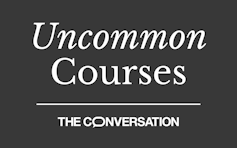
"Uncommon Courses" is an occasional series from The Conversation US that focuses on non-traditional teaching methods.
Course name:
Art and Publicity
What sparked the idea for this course?
I love taking lawyers and law students to art museums. Initially, I incorporated these activities into the courses I taught on Persuasion, Creativity, and Artificial Intelligence. But the response was so positive—and the conversations so rich and interesting—that art and advocacy became its own course.
What does the course explore?
Students examine the intellectual, emotional, and professional overlap between the techniques of presenting art and the techniques of presenting arguments. Both activities involve storytelling. Both involve putting yourself in someone else’s shoes. Both rely on the right balance of evidence and emotion, comprehensiveness and simplicity, provocation and restraint.
Why is this course relevant now?
Advocacy—whether in court, in boardrooms, or in private discussions and debates—is in many ways an act of planning. It requires highlighting themes and making connections. It requires wise choices. It places a premium on context, contrast, and bold, transformative vision.
But most importantly, advocacy, like art, involves the ability to connect with different audiences simultaneously and push them to see legal issues, people, and ideologies in new ways. We can all learn a lot about how to develop and use this ability by spending time looking at art collected and strategically arranged in a museum.
What are the key lessons from this course?
The best advocates can serve as helpful guides. They do not impose their views on others. They don’t hit us with dogma or overwhelm us with irrelevant details. Instead, like skilled museum curators, they focus on directing our attention, ultimately enabling us to make more informed, evidence-based judgments and decisions.
The goal is to inspire, not force.
What materials are included in the course?
Part of the fun of this course is the ever-dynamic syllabus, as the museums we visit are constantly updating their collections and offering new exhibits.
We saw the Van Gogh in America exhibition at the Detroit Institute of Arts. We saw work by Kara Walker and Kehinde Wiley at the University of Michigan Art Museum. We even managed to include works by Monet, Rothko and Picasso.
What will this course help students do?
Become a better visual advocate. Litigation attorneys need to be good visual advocates, especially when presenting evidence. Dealmakers need to be good visual advocates, especially when pitching projects. The same goes for anyone presenting in person, online, or through a hybrid arrangement.
If you only operate with sentences and paragraphs, you'll miss opportunities to convey your message and connect with people in other creative, memorable ways.